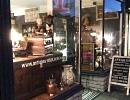Contact Seller
Westbank Antiques
Tel0151 6510522or07450873305Please quote Antiques Atlas.


 18th Century Carved Polychrome Coat of Arms Plaque
18th Century Carved Polychrome Coat of Arms Plaque
 Sir Edward Massey Portrait Wall Sculpture
Sir Edward Massey Portrait Wall Sculpture
 Venetian Carnival Sun Mask Wall Sculpture
Venetian Carnival Sun Mask Wall Sculpture
 Bronze Heraldry Military Knighthood OBE Coat Arms
Bronze Heraldry Military Knighthood OBE Coat Arms
 19th Century Pugin Tiger Oak Heraldry Lion Plaque
19th Century Pugin Tiger Oak Heraldry Lion Plaque
 Large Owl Roundel Pottery Plaque by Williamson
Large Owl Roundel Pottery Plaque by Williamson
 Painted Scripture of the Commandments on Slate
Painted Scripture of the Commandments on Slate
 Portrait Flemish Sir Peter Rubens Copper Plaque
Portrait Flemish Sir Peter Rubens Copper Plaque
 19th Century Coalbrookdale Bronze Circular Plaque
19th Century Coalbrookdale Bronze Circular Plaque
 Mid Century Wall Sculpture by Elizabeth Lewis
Mid Century Wall Sculpture by Elizabeth Lewis
 Mid Century Wall Sculpture by Elizabeth Lewis
Mid Century Wall Sculpture by Elizabeth Lewis
 A Unique Building Wall Plaque "porcelaine De Paris
A Unique Building Wall Plaque "porcelaine De Paris
Non UK callers :
+44 151 6510522
or +44 7450873305
or +44 7450873305
Leonardo da Vinci


A very unusual item indeed.
I have never seen another like it.
There are many last supper plaques available, mass produced modern reproductions.
This is clearly a one off piece
19th Century or earlier bronze panel.
Portrait of Leonardo da Vinci set within a wreath with the last supper below.
The words Leonardo da Vinci PIT. S.A.M.P.
The detail is wonderful.
Another unusual feature of this panel is the snake eating a child top centre of panel (Biscione)
The emblem of the Visconti is the symbol of Milan
The Biscione ('large grass snake'), also known as the Vipera (‘viper’ or in Milanese as the Bissa), is a heraldic charge showing a blue serpent in the act of swallowing a human – usually a child, and sometimes described as a Moor. It has been the emblem of the Italian Visconti family for around a thousand years.
According to the legend, in the 1100s, Ottone Visconti, during the Second Crusade, led an army of Milanese citizens in the siege of Jerusalem, and challenged the cruel Saracen Voluce to a duel. Voluce’s coat of arms was a snake devouring a man. Ottone killed the Saracen, took his weapons and his symbol and brought it to Milan and decided to adopt the warrior’s coat of arm as his own. The symbol of the House of Visconti was born and, when the Visconti family gained control of Milan, the biscione became the symbol of the city. The man eaten by the snake was replaced by a red Saracen and later became a child, with the aim of showing the goodness of the Visconti’s snake.
This panel was once obviously set into a wall and still has the remains of plaster,cement to the reverse.
It would be make wonderful and unique piece of art when framed.
More images upon request
Size
Width 11.75 inches
Height 11 inches
PricePlease telephone 07450873305. 0151-651-0522. stevedavies_52@msn.com DimensionsWidth 11.75 inches Height 11 inches Category Architectural Antiques - Salvage - Reclamation Period 19th Century Antiques Material Bronze Origin Italian Item code as610a315 / aa400 Status Sold
SellerWestbank Antiques
View all stock from
Westbank Antiques

 Private dealer, By appointment only.
Private dealer, By appointment only.
Hoylake, Wirral
Merseyside
North West England
Tel : 0151 6510522
or : 07450873305
Non UK callers : +44 151 6510522 or +44 7450873305
I have never seen another like it.
There are many last supper plaques available, mass produced modern reproductions.
This is clearly a one off piece
19th Century or earlier bronze panel.
Portrait of Leonardo da Vinci set within a wreath with the last supper below.
The words Leonardo da Vinci PIT. S.A.M.P.
The detail is wonderful.
Another unusual feature of this panel is the snake eating a child top centre of panel (Biscione)
The emblem of the Visconti is the symbol of Milan
The Biscione ('large grass snake'), also known as the Vipera (‘viper’ or in Milanese as the Bissa), is a heraldic charge showing a blue serpent in the act of swallowing a human – usually a child, and sometimes described as a Moor. It has been the emblem of the Italian Visconti family for around a thousand years.
According to the legend, in the 1100s, Ottone Visconti, during the Second Crusade, led an army of Milanese citizens in the siege of Jerusalem, and challenged the cruel Saracen Voluce to a duel. Voluce’s coat of arms was a snake devouring a man. Ottone killed the Saracen, took his weapons and his symbol and brought it to Milan and decided to adopt the warrior’s coat of arm as his own. The symbol of the House of Visconti was born and, when the Visconti family gained control of Milan, the biscione became the symbol of the city. The man eaten by the snake was replaced by a red Saracen and later became a child, with the aim of showing the goodness of the Visconti’s snake.
This panel was once obviously set into a wall and still has the remains of plaster,cement to the reverse.
It would be make wonderful and unique piece of art when framed.
More images upon request
Size
Width 11.75 inches
Height 11 inches
PricePlease telephone 07450873305. 0151-651-0522. stevedavies_52@msn.com DimensionsWidth 11.75 inches Height 11 inches Category Architectural Antiques - Salvage - Reclamation Period 19th Century Antiques Material Bronze Origin Italian Item code as610a315 / aa400 Status Sold
View all stock from
Westbank Antiques

 Private dealer, By appointment only.
Private dealer, By appointment only.Hoylake, Wirral
Merseyside
North West England
Tel : 0151 6510522
or : 07450873305
Non UK callers : +44 151 6510522 or +44 7450873305
You may also be interested in
 18th Century Carved Polychrome Coat of Arms Plaque
18th Century Carved Polychrome Coat of Arms Plaque
 Sir Edward Massey Portrait Wall Sculpture
Sir Edward Massey Portrait Wall Sculpture
 Venetian Carnival Sun Mask Wall Sculpture
Venetian Carnival Sun Mask Wall Sculpture
 Bronze Heraldry Military Knighthood OBE Coat Arms
Bronze Heraldry Military Knighthood OBE Coat Arms
 19th Century Pugin Tiger Oak Heraldry Lion Plaque
19th Century Pugin Tiger Oak Heraldry Lion Plaque
 Large Owl Roundel Pottery Plaque by Williamson
Large Owl Roundel Pottery Plaque by Williamson
 Painted Scripture of the Commandments on Slate
Painted Scripture of the Commandments on Slate
 Portrait Flemish Sir Peter Rubens Copper Plaque
Portrait Flemish Sir Peter Rubens Copper Plaque
 19th Century Coalbrookdale Bronze Circular Plaque
19th Century Coalbrookdale Bronze Circular Plaque
 Mid Century Wall Sculpture by Elizabeth Lewis
Mid Century Wall Sculpture by Elizabeth Lewis
 Mid Century Wall Sculpture by Elizabeth Lewis
Mid Century Wall Sculpture by Elizabeth Lewis
 A Unique Building Wall Plaque "porcelaine De Paris
A Unique Building Wall Plaque "porcelaine De Paris







